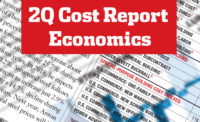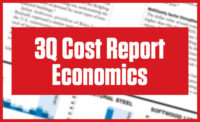Economics
2Q 2024 Cost Report: Private Construction Struggles in Second Quarter
Single-family, hotel work see positive movement within the sector

Related Link:
ENR 2024 2Q Cost Report PDF
(Subscription Required)
Public work continues to spur growth in the construction industry in the second quarter as contractors wait for interest rates to decline in the second half of the year.
“At the five-month point of the year, construction starts are expanded at a modest pace with the dollar value of construction starts up 11% on a year-to-date basis through May,” says Richard Branch, chief economist at Dodge Construction Network. “However, that expansion is mostly bifurcated, with publicly funded projects outperforming the private sector.”
Through the first five months of the year, residential construction starts are up 16%, according to Dodge. Single-family starts increased 29%. “All the growth is occurring in single family, despite mortgage rates that have remained near 7%,” Branch says, while multifamily has been on the decline, with starts 5% below the same time last year. The largest multifamily projects to begin in the last two months were the $270-million Innovative Urban mixed-use project in East New York, and the $200-million Atlantic Club in Long Branch, N.J.
In the non-residential market, starts rose 3%, year-to-date, through May. The increase is “led mostly by the institutional sectors of health care, education, recreation and transportation,” says Branch. On the commercial side, hotel starts saw the only increase, at a rate of 63%. Among the biggest non-residential projects to start in the second quarter were the $3.7-billion UC Davis Health Medical Center’s California hospital tower in Sacramento and the $2.1-billion Tennessee Titans football arena in Nashville.
Non-building starts, still bolstered by funds from the Infrastructure Investment and Jobs Act, are up 17% in the first five months of 2024. All types of starts in this market experienced increases over the same time last year, led by utilities at 35% and environmental public works, at a rate of 24%. The largest infrastructure projects to break ground in April and May were the $10.5-billion trains 1 and 2 of the Port Arthur LNG plant in Port Arthur, Texas, and the $9.8-billion Dominion Energy Coastal Offshore Wind Project off Virginia Beach, Va.
Going forward, Branch expects growth to improve on the private side. “High interest rates have weighed on the pattern of starts this year, but the stability in the Dodge Momentum Index, which tracks projects in the planning stage, provides optimism that once rates start to move lower a broader acceleration in starts will occur.”
“[Construction starts are] mostly bifurcated, with publicly funded projects outperforming the private sector.”
Richard Branch, chief economist, Dodge Construction Network
Paul Brussow, president of Rider Levett Bucknall, also expects falling interest rates to spur construction, particularly on the residential side. “Throughout the second half of the year, mortgage rates should decrease in tandem with Treasury yields,” he says. “This should offer a little more support for residential demand through increased affordability.”
While interest rates will ease, the labor shortage continues, causing wages to rise. “Wages as opposed to materials are our main concern when thinking about construction costs in 2024,” says Michael Guckes, senior economist at ConstructConnect. “We remain most concerned over the ability of the industry to improve labor productivity as a way to combat a fourth consecutive year in which construction wages are likely to rise another 4-5%.”
Lumber, Steel Prices Are Down
“Softwood lumber prices have fallen significantly from where they were just two to three months ago,” says Luke Lillehaugen, senior economist at S&P Global Market Intelligence. “Prices rose in the first quarter due to supply tightness, but have since been pushed back down as changing expectations for the timing of monetary policy easing from the Federal Reserve resulted in weaker lumber demand.”
In its second quarter forecast, S&P Global Market Intelligence predicts a 5.8% drop overall in softwood lumber prices this year, with a 4.2% rebound in 2025. Plywood prices are expected to drop 0.6% in 2024, with an additional 0.9% decline next year.
In the steel market, prices “continue to drop,” says John Anton, economics director at S&P Global Intelligence. “U.S. prices were the slowest to decline after the global 2022 spike. So in many ways the declines are simply equalization rather than signs of underlying weakness.”
S&P Global Market Intelligence forecasts reinforcing bar prices to drop 11.6% in 2024, falling another 2.5% next year. Structural shapes prices are expected to decrease 16.5% and 16.2% in 2024 and 2025, respectively.
“Prices are expected to find a floor in early 2025, with some products possibly hitting bottom by the end of 2024,” says Anton. “Global prices may have some sharp drops if mainland China has to liquidate excess construction steel inventory, but the U.S. is largely insulated by protectionism.”




